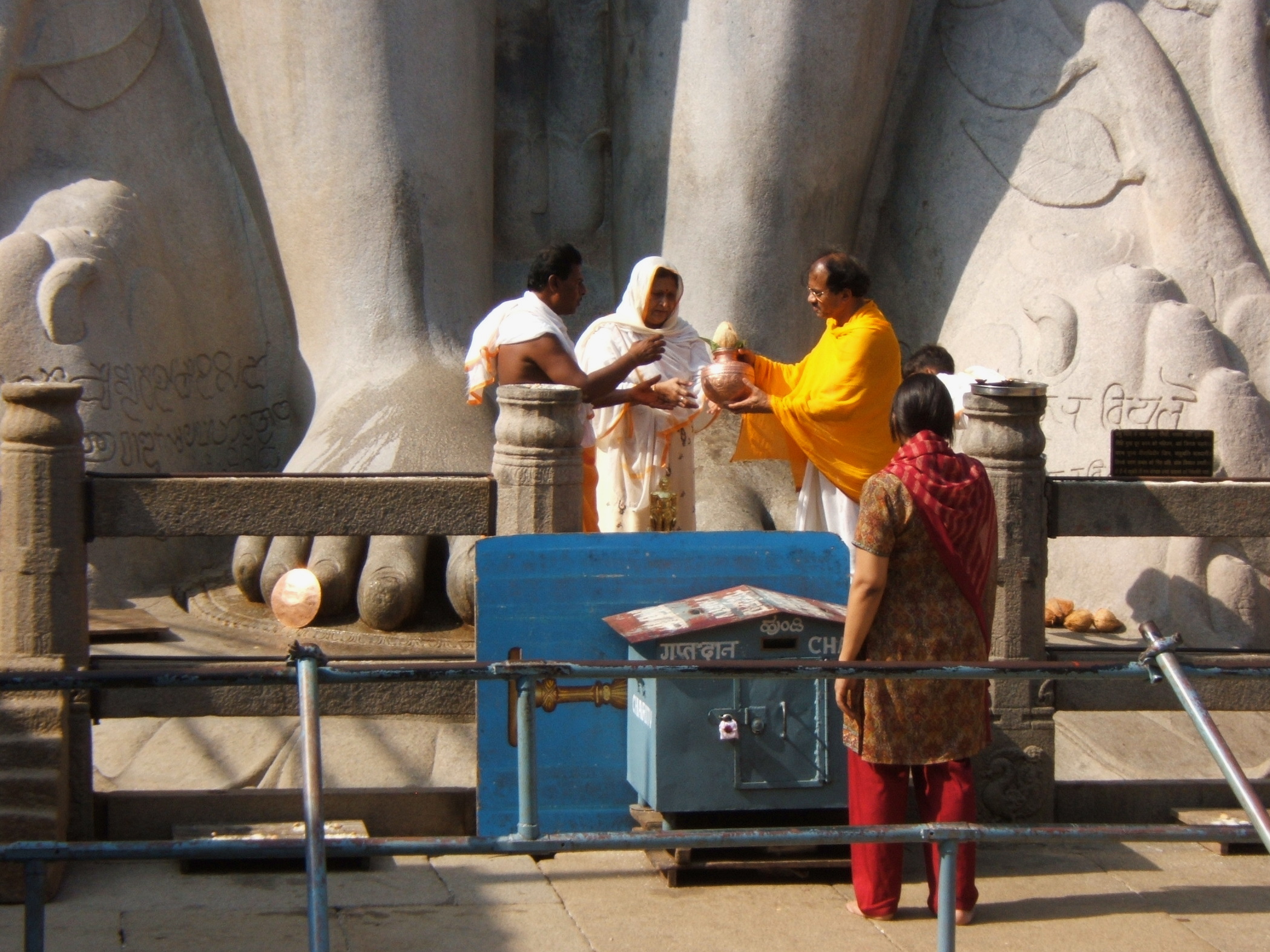|
Mahavratas
Jain ethical code prescribes two ''dharmas'' or rules of conduct. One for those who wish to become ascetic and another for the ''śrāvaka'' (householders). Five fundamental vows are prescribed for both votaries. These vows are observed by '' śrāvakas'' (householders) partially and are termed as ''anuvratas'' (small vows). Ascetics observe these fives vows more strictly and therefore observe complete abstinence. These five vows are: * ''Ahiṃsā'' (Non-violence) * ''Satya'' (Truth) * ''Asteya'' (Non-stealing) * ''Brahmacharya'' (Chastity) * ''Aparigraha'' (Non-possession) According to Jain text, ''Puruşārthasiddhyupāya'': Apart from five main vows, a householder is expected to observe seven supplementary vows (''śeelas'') and last '' sallekhanā'' vow. ''Maha vratas'' (major vows) ''Mahavrata'' (lit. major vows) are the five fundamental observed by the Jain ascetics. According to Acharya Samantabhadra’s Ratnakaraņdaka śrāvakācāra: Ahiṃsā Ahimsa (non-inj ... [...More Info...] [...Related Items...] OR: [Wikipedia] [Google] [Baidu] |
Jain Ascetics
Jain monasticism refers to the order of monks and nuns in the Jain community and can be divided into two major denominations: the ''Digambara'' and the ''Śvētāmbara''. The monastic practices of the two major sects vary greatly, but the major principles of both are identical. Five ''mahāvratas'' (Great Vows), from Mahavira's teachings, are followed by all Jain ascetics. Historians believe that a united Jain ''sangha'' (community) existed before 367 BCE, about 160 years after the ''moksha'' (liberation) of Mahavira. The community then gradually divided into the major denominations. Terminology ''Digambaras'' use the word ' for male monastics and ''aryika'' for female monastics. ''Digambara monks'' are also called ''nirgrantha'' (without bonds). ''Śvētāmbaras'' use the word ''sadhvi''s for female monastics. History Mahavira had 11 chief disciples, Indrabhuti Gautama being the most senior. Each chief disciple was made responsible for 250 to 500 monks. The Jain sangha ( ... [...More Info...] [...Related Items...] OR: [Wikipedia] [Google] [Baidu] |
Jain Monasticism
Jain monasticism refers to the order of monks and nuns in the Jain community and can be divided into two major denominations: the ''Digambara'' and the ''Śvētāmbara''. The monastic practices of the two major sects vary greatly, but the major principles of both are identical. Five ''mahāvratas'' (Great Vows), from Mahavira's teachings, are followed by all Jain ascetics. Historians believe that a united Jain ''sangha'' (community) existed before 367 BCE, about 160 years after the ''moksha'' (liberation) of Mahavira. The community then gradually divided into the major denominations. Terminology ''Digambaras'' use the word ' for male monastics and ''aryika'' for female monastics. ''Digambara monks'' are also called ''nirgrantha'' (without bonds). ''Śvētāmbaras'' use the word ''sadhvi''s for female monastics. History Mahavira had 11 chief disciples, Indrabhuti Gautama being the most senior. Each chief disciple was made responsible for 250 to 500 monks. The Jain sangha ... [...More Info...] [...Related Items...] OR: [Wikipedia] [Google] [Baidu] |
Śrāvaka (Jainism)
In Jainism, the word Śrāvaka or Sāvaga (from Jain Prakrit) is used to refer the Jain laity (householder). The word ''śrāvaka'' has its roots in the word ''śrāvana'', i.e. the one who listens (the discourses of the saints). The ''tirthankara'' restores or organises the ''sangha'', a fourfold order of ''muni'' (male monastics), ''aryika'' (female monastics), '' śrāvaka''s (male followers) and ''śrāvikā''s (female followers). In Jainism, there are two kinds of votaries: *The householder (one with minor vows) *The homeless ascetic (one with major vows) According to the Jain text ''Puruşārthasiddhyupāya'': Ratnakaranda śrāvakācāra, a major Jain text, discusses the conduct of a Śrāvaka in detail. Six essentials In Jainism, six essential duties (''avashyakas'') are prescribed for a ''śrāvaka''. These help the laity in achieving the principle of ahimsa which is necessary for his/her spiritual upliftment. The six duties are: #Worship of Pañca-Parameṣṭhi ... [...More Info...] [...Related Items...] OR: [Wikipedia] [Google] [Baidu] |
Jain Philosophy
Jain philosophy refers to the ancient Indian philosophy, Indian philosophical system found in Jainism. One of the main features of Jain philosophy is its Mind–body dualism, dualistic metaphysics, which holds that there are two distinct categories of existence, the living, conscious or sentient being (''jiva'') and the non-living or Matter, material (''ajiva''). Jain texts discuss numerous philosophical topics such as epistemology, metaphysics, ethics, cosmology and soteriology. Jain thought is primarily concerned with understanding the nature of living beings, how these beings are bound by karma (which are seen as fine material particles) and how living beings may be liberated (''moksha'') from the cycle of reincarnation. Also notable is the Jain belief in a beginning-less and Cyclic model, cyclical universe and a rejection of a Creator deity. From the Jain point of view, Jain philosophy is eternal and has been taught numerous times in the remote past by the great enlightened ... [...More Info...] [...Related Items...] OR: [Wikipedia] [Google] [Baidu] |
Uttarakhand
Uttarakhand ( , or ; , ), also known as Uttaranchal ( ; the official name until 2007), is a state in the northern part of India. It is often referred to as the "Devbhumi" (literally 'Land of the Gods') due to its religious significance and numerous Hindu temples and pilgrimage centres found throughout the state. Uttarakhand is known for the natural environment of the Himalayas, the Bhabar and the Terai regions. It borders the Tibet Autonomous Region of China to the north; the Sudurpashchim Province of Nepal to the east; the Indian states of Uttar Pradesh to the south and Himachal Pradesh to the west and north-west. The state is divided into two divisions, Garhwal and Kumaon, with a total of 13 districts. The winter capital of Uttarakhand is Dehradun, the largest city of the state, which is a rail head. Bhararisain, a town in Chamoli district, is the summer capital of Uttarakhand. The High Court of the state is located in Nainital. Archaeological evidence supports the e ... [...More Info...] [...Related Items...] OR: [Wikipedia] [Google] [Baidu] |
Acharya (Jainism)
''Āchārya'' () means the Head of an order of ascetics. Some of the famous achāryas are Bhadrabahu, Kundakunda, Samantabhadra, Umaswami, Sthulibhadra. In Digambara Jainism, ''Āchārya'' has thirty-six primary attributes (''mūla guṇa'') consisting in: *Twelve kinds of austerities (''tapas''); *Ten virtues (''dasa-lakṣaṇa dharma''); *Five kinds of observances in regard to faith, knowledge, conduct, austerities, and power. *Six essential duties (''Ṣadāvaśyaka''); and *''Gupti''- Controlling the threefold activity of: **the body; **the organ of speech; and **the mind. According to the Jain text, ''Dravyasamgraha'', Chandanaji became the first Jain woman to receive the title of Acharya in 1987. Mūla Guṇa Twelve kinds of austerities (''tapas'') ;External austerities The external austerities (''bāhya tapas'') are fasting (''anaśana''), reduced diet (''avamaudarya''), special restrictions for begging food (''vrttiparisamkhyāna''), giving up stimulating and ... [...More Info...] [...Related Items...] OR: [Wikipedia] [Google] [Baidu] |
Tapas (Indian Religions)
Tapas (Sanskrit: तपस्) is a variety of austere spiritual meditation practices in Indian religions. In Jainism, it means asceticism (austerities, body mortification); in Buddhism, it denotes spiritual practices including meditation and self-discipline; and in the different traditions within Hinduism it means a spectrum of practices ranging from asceticism, inner cleansing to self-discipline by meditation practices. The ''Tapas'' practice often involves solitude, and is a part of monastic practices that are believed to be a means to moksha (liberation, salvation). In the Vedas literature of Hinduism, fusion words based on ''tapas'' are widely used to expound several spiritual concepts that develop through heat or inner energy, such as meditation, any process to reach special observations and insights, the spiritual ecstasy of a yogin or ''Tāpasa'' (a vṛddhi derivative meaning "a practitioner of austerities, an ascetic"), even warmth of sexual intimacy.Kaelber, W. O. (197 ... [...More Info...] [...Related Items...] OR: [Wikipedia] [Google] [Baidu] |
Ethics
Ethics or moral philosophy is a branch of philosophy that "involves systematizing, defending, and recommending concepts of right and wrong behavior".''Internet Encyclopedia of Philosophy'' The field of ethics, along with aesthetics, concerns matters of value; these fields comprise the branch of philosophy called axiology. Ethics seeks to resolve questions of human morality by defining concepts such as good and evil, right and wrong, virtue and vice, justice and crime. As a field of intellectual inquiry, moral philosophy is related to the fields of moral psychology, descriptive ethics, and value theory. Three major areas of study within ethics recognized today are: # Meta-ethics, concerning the theoretical meaning and reference of moral propositions, and how their truth values (if any) can be determined; # Normative ethics, concerning the practical means of determining a moral course of action; # Applied ethics, concerning what a person is obligated (or permitted) to do ... [...More Info...] [...Related Items...] OR: [Wikipedia] [Google] [Baidu] |
Karma In Jainism
Karma is the basic principle within an overarching psycho-cosmology in Jainism. Human moral actions form the basis of the transmigration of the soul ('). The soul is constrained to a cycle of rebirth, trapped within the temporal world ('), until it finally achieves liberation ('). Liberation is achieved by following a path of purification. Jains believe that karma is a physical substance that is everywhere in the universe. Karma particles are attracted to the soul by the actions of that soul. Karma particles are attracted when we do, think, or say things, when we kill something, when we lie, when we steal and so on. Karma not only encompasses the causality of transmigration, but is also conceived of as an extremely subtle matter, which infiltrates the soul—obscuring its natural, transparent and pure qualities. Karma is thought of as a kind of pollution, that taints the soul with various colours ('' leśyā''). Based on its karma, a soul undergoes transmigration and reinca ... [...More Info...] [...Related Items...] OR: [Wikipedia] [Google] [Baidu] |
Tattvarthasutra
''Tattvārthasūtra'', meaning "On the Nature '' ''artha">nowiki/>''artha''.html" ;"title="artha.html" ;"title="nowiki/>''artha">nowiki/>''artha''">artha.html" ;"title="nowiki/>''artha">nowiki/>''artha''of Reality [''tattva'']" (also known as ''Tattvarth-adhigama-sutra'' or ''Moksha-shastra'') is an ancient Jain text written by ''Acharya (Jainism), Acharya'' Umaswami in Sanskrit, sometime between the 2nd- and 5th-century CE. The ''Tattvārthasūtra'' is regarded as one of the earliest, most authoritative texts in Jainism. It is accepted as authoritative in both its major sub-traditions – ''Digambara'' and ''Śvētāmbara'' – as well as the minor sub-traditions. It is a philosophical text, and its importance in Jainism is comparable with that of the ''Brahma Sutras'' and ''Yoga Sutras of Patanjali'' in Hinduism. In an aphoristic sutra style of ancient Indian texts, it presents the complete Jainism philosophy in 350 sutras over 10 chapters. The text has attracted numerous c ... [...More Info...] [...Related Items...] OR: [Wikipedia] [Google] [Baidu] |








